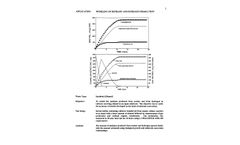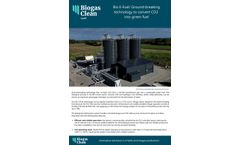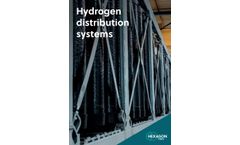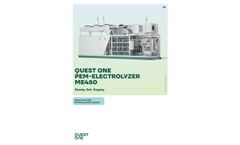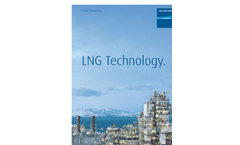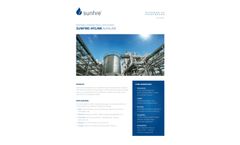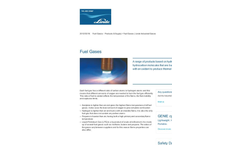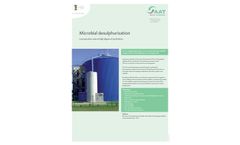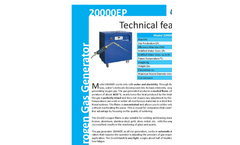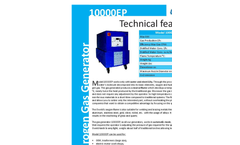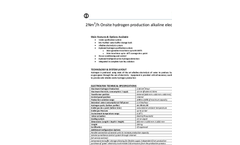of-nuclear-hydrogen-production Downloads
29 downloads found
Premium
Analysis of TOC/TN in Product Quality Monitoring of Hydrogen ...
Premium
Waste Type: Synthetic (Ethanol). Objective: To model the methane produced from acetate and from hydrogen in cultures receiving ethanol as an input substrate. The objective was to verify the accuracy of models developed on the basis of substrate conversion. ...
Premium
Ground-breaking technology that converts CO2 from a harmful greenhouse gas into a sustainable green fuel. The biological process in the Bio E-Fuel reactor converts CO2 and hydrogen into methane, which unlike electricity, can be stored, an important advantage. Hydrogen is produced from the electrolysis of water. Our Bio E-Fuel technology can be applied anywhere there is a CO2 source. Biogas plants ...
TRIOCTYL PHOSPHATE is used for hydrogen peroxide production. Trioctyl phosphate, as the solvent of hydroanthraquinone, has the conditions of high solubility of hydroanthraquinone, high partition coefficient of hydrogen peroxide between water and solvent, high boiling point and high ignition point. ...
Low CAPEX – optimized Balance-of-Plant configuration Robust system– 10-year product warranty Low LCOH – due to high efficiency and bar output pressure Turnkey solution – containerized full system for green hydrogen ...
Distribution is considered to be a big problem for the future of hydrogen as a fuel. But at Hexagon Purus we focus on the solution. Able to transport up to 1.1 tons of hydrogen, our X-STORE® modules have the largest transport capacity worldwide, made to deliver hydrogen from the production sites to the filling stations as well as to industrial clients. Due to their extremely light weight, ...
Plug-and-play hydrogen: The Quest One ME450 electrolyzer is a proven turn-key solution for the easy and efficient production of green hydrogen. In the space of just one standard 40-foot container, enough hydrogen can be produced to refuel 90 cars daily. Each ME450 has an electrolysis capacity of 1 MW and can produce 450 kg of high purity hydrogen per day. Thanks to a multiple stack design, high ...
Hydrogen (H2) is produced by steam reforming, partial oxidation of hydrocarbons and by the conversion of carbon monoxide and purified by pressure swing adsorption or through the purification of refinery purge ...
Give your students the edge by teaching them about hydrogen production with this exciting and safe demonstration unit. The AutoARK® Ed comes complete with its own set of workbooks, efficiency calculator, and video. One CD contains all you need to provide curriculum and training for all students and staff. The student workbook includes review sections complete with questions. The curriculum ...
Sunfire’s ultra-reliable pressurized Alkaline electrolyzer is optimal for applications without or with limited steam availability. With a proven system lifetime of at least 90,000 operating hours, the electrolyzer is our established solution for renewable hydrogen production. The electrolyzer has a scalable system design. One system produces 2,230 Nm³/h hydrogen at 30 bar(g) with a ...
AAT microbial desulphurization is used to reduce hydrogen sulphide in biogas, WWTP and landfill plants on an ecological basis. Apart from methane and carbon dioxide, toxic hydrogen sulphide is produced in fermentation process as well. This acts corrosively on the consumers and equipment. ...
With the HC process, high purity hydrogen is produced by steam reforming of a hydrocarbon combined with a PSA purification step. The feed is mixed with a split stream of hydrogen and then preheated in the heat exchanger prior to passing a sulphur removal. The feed is then mixed with superheated steam. Whilst passing the catalyst in the reformer tubes, the mixture of water vapour and feed is ...
This gas generator works only with water and electricity through the process of water’s electrolysis. The gas generated (hydrogen and oxygen) produces a neutral flame which develops a temperature of about 3650 °C and can weld, braze or solder all non-ferrous materials in a short time compared to traditional systems. The gas coming out perfectly mixed and does not require any adjustment ...
This gas generator works only with water and electricity through the process of water’s electrolysis. The gas generated (hydrogen and oxygen) produces a neutral flame which develops a temperature of about 3650 °C and can weld, braze or solder all non-ferrous materials in a short time compared to traditional systems. The gas coming out perfectly mixed and does not require any adjustment ...
This gas generator works only with water and electricity through the process of water’s electrolysis. The gas generated (hydrogen and oxygen) produces a neutral flame which develops a temperature of about 3650 °C and can weld, braze or solder all non-ferrous materials in a short time compared to traditional systems. The gas comes out perfectly mixed and does not require any adjustment ...
This gas generator works only with water and electricity through the process of water’s electrolysis. The gas generated (hydrogen and oxygen) produces a neutral flame which develops a temperature of about 3650 °C and can weld, braze or solder all non-ferrous materials in a short time compared to traditional systems. The gas coming out perfectly mixed and does not require any adjustment ...
Hydrogen is produced using state of the art alka line electrolysis of water to produce hydrogen & oxygen gases through the use of electricity. Equipment is provided with all necessary auxiliary items to provide safe reliable onsite hydrogen ...
BayoTech’s steam methane reformers are more energy efficient than traditional hydrogen production. Building on technology first developed by Sandia National Laboratory, BayoTech’s proprietary design leverages high heat recuperation to achieve greater energy efficiency. Our patented reformer uses 20-30% less energy, saving money and reducing carbon footprint. ...
ByBayoTech
Ammonia is used in a variety of applications in the petrochemical industry. It can be used as a fertilizer or it can be reacted with other compounds to form fertilizers, nitric acid, explosives and synthetic fibers. It is also used as a refrigerant in large cooling systems. The ammonia plant starts with methane and/or other light hydrocarbons that is treated to remove any trace sulfur compounds. ...


